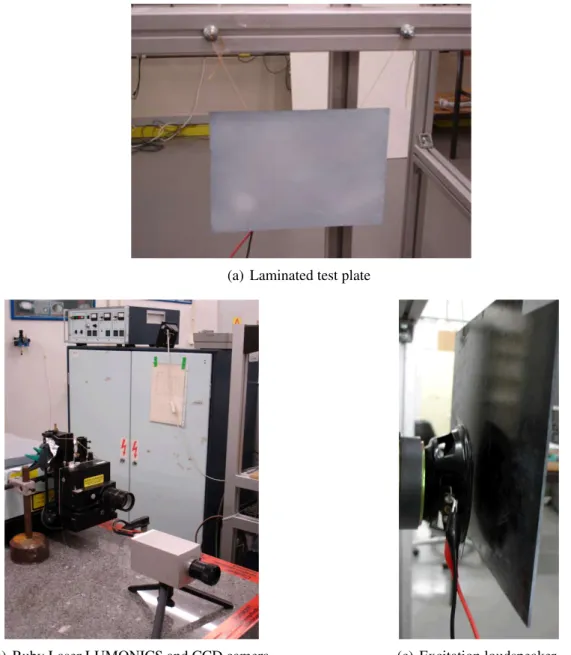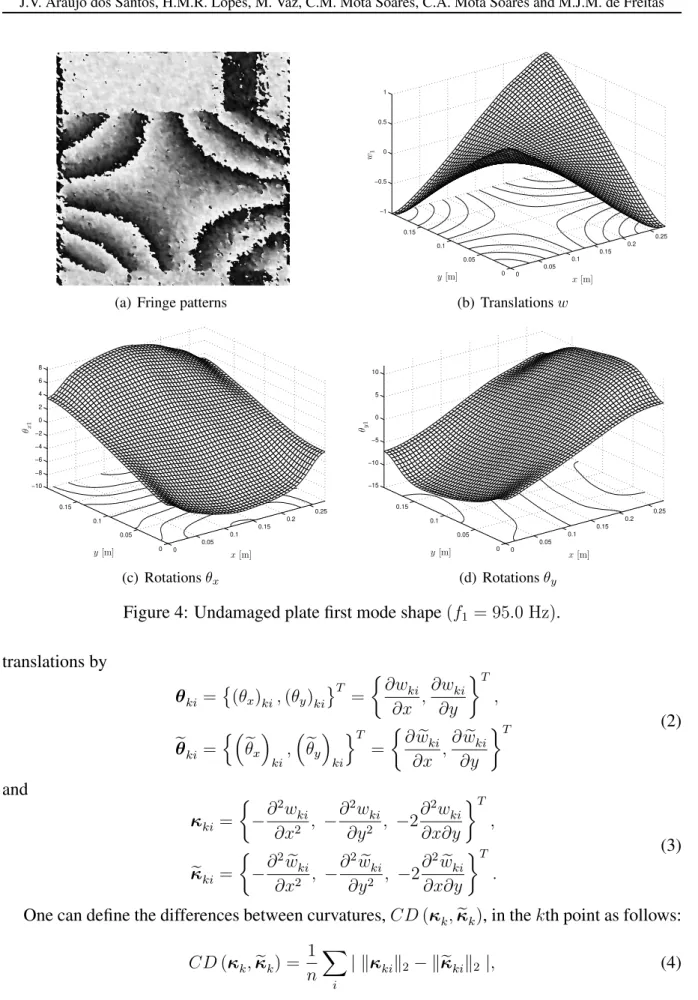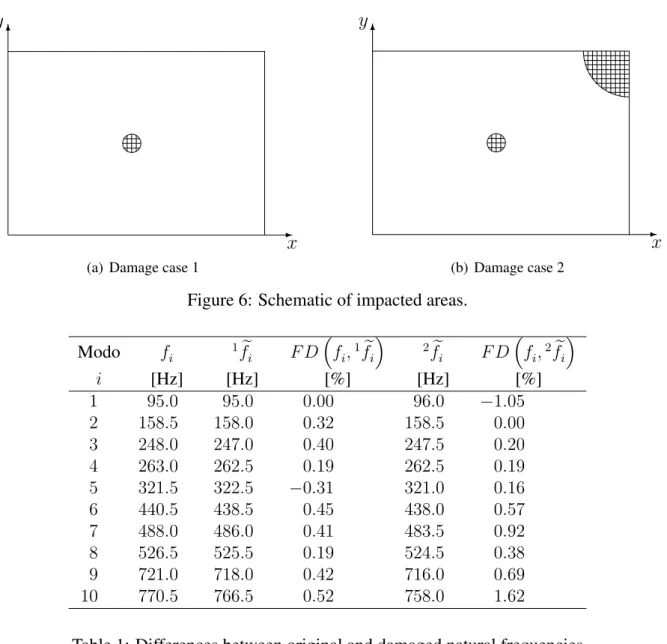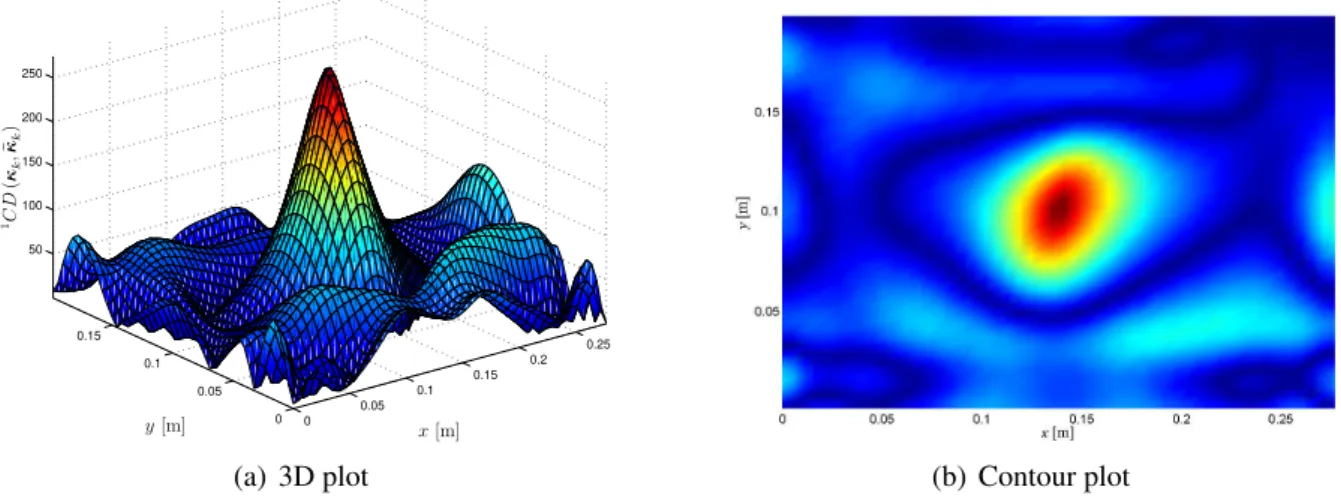Lisbon, Portugal, 5–8 June 2006
DAMAGE LOCALIZATION IN LAMINATED COMPOSITE PLATES
USING DOUBLE PULSE-ELECTRONIC HOLOGRAPHIC
INTERFEROMETRY
J.V. Ara ´ujo dos Santos1
, H.M.R. Lopes2
, M. Vaz3
, C.M. Mota Soares1
, C.A. Mota Soares1
, and M.J.M. de Freitas4
1
IDMEC/IST, Instituto Superior T´ecnico Av. Rovisco Pais, 1049-001 Lisboa, Portugal
jsantos@dem.ist.utl.pt cmmsoares@alfa.ist.utl.pt carlosmotasoares@dem.ist.utl.pt
2
ESTIG - Instituto Polit´ecnico de Braganc¸a
Campus de Sta Apol´onia, Apartado 134, 5301-857 Braganc¸a, Portugal hlopes@ipb.pt
3
DEMEGI - Faculdade de Engenharia do Porto Rua Dr. Roberto Frias, 4200-465 Porto, Portugal
gmavaz@fe.up.pt
4
ICEMS/UME, Instituto Superior T´ecnico Av. Rovisco Pais, 1049-001 Lisboa, Portugal
mfreitas@dem.ist.utl.pt
Keywords: Damage Localization, Laminated Plate, Mode Shape Curvature, Double Pulse-Electronic Holographic Interferometry, Acoustic Excitation, Non Destructive Inspection.
1 INTRODUCTION
In recent years the use of laminated composite materials in many mechanical and aerospace engineering structures has seen a huge increase, due, among other factors, to their specific stiff-ness and strength. However, because of these materials characteristics, damage can be produced during fabrication or by inappropriate or hazardous service loads. Delamination is one the most common and dangerous damages, caused by internal failure of the laminas interface. These internal damages can be undetected by visual inspection. Therefore, in order to assess the struc-ture integrity, non destructive inspection methods are needed for damage localization. The most used non destructive inspection methods are either visual or localized experimental methods such as acoustic or ultrasonic methods, magnet field methods, radiographs, eddy-current meth-ods and thermal field methmeth-ods [1]. These experimental methmeth-ods can detect damage on or near the surface of the structure [1], therefore not allowing the detection of delaminations.
The use of vibration based delamination identification and health monitoring techniques for
composite structures have been surveyed by Zouet al. [2]. The level of success in identifying
damage is directly related to the sensitivity of the applied measurement technique and the pa-rameters used in the identification methodology. Abdo and Hori [3], showed numerically that damage localization by mode shapes can be more easily accomplished if rotation differences are involved. However, in the presence of small defects with noisy data, obtained from experi-mental measurement, the use of rotations can mislead the damage localization. In these cases, a higher sensitivity parameter, like the curvature or strain energy, could be used instead [4, 5].
One method for the damage localization of impact damage in laminated composite plates, based on mode shapes curvature differences, is presented, applied and discussed in this paper. The measurement of mode shapes translations is performed using double pulse-electronic holo-graphic interferometry and the plate is excited acoustically. In order to overcome the problem of differentiating noisy data, the rotations and curvatures are obtained by numerical differentiation of modes shapes translations using a differentiation/smoothing technique [6, 7, 8, 9, 10, 11].
The proposed methodology was applied to a carbon fiber reinforced epoxy rectangular plate, free in space, subjected to two cases of impact damage. The results of applying the mentioned method showed that the curvature differences allow the localization of both cases of damage, which can be undetected by visual, standard X-ray or C-Scan inspections. Finally, it was also found that the best localizations are achieved by selecting the most changed mode, due to the presence of damage.
2 EXPERIMENTAL SETUP
A carbon fiber reinforced epoxy rectangular plate, with a [0/90/+45/−45/0/90]s stacking
sequence, was analyzed before and after being damaged by impact using the experimental
tech-niques described in this Section. The plate in-plane dimensions are277.0mm×199.0mm and
its thickness is 1.80 mm. The specific mass is ρ = 1562kg/m3
and the laminas mechanical
properties are E1 = 123.4 GPa, E2 = 8.6 GPa, G12 = G13 = 5.0 GPa, G23 = 6.1 GPa,
ν12 = 0.14, which were obtained using a technique described in [12]. The first ten natural
fre-quencies of the plate were obtained from its Frequency Response Functions (FRFs). The plate was suspended with high flexible rubber bands creating a nearly free condition. A transient
excitation was performed with an impact hammer Br¨uel & Kjær model 8203 and a non
con-tact measurement of the plate response was carried out with a microphone. Both signals were
processed in aBr¨uel & Kjær analyzer, model 2148. In Figure 1 is shown a view of the setup
Figure 1: Experimental setup for Frequency Response Functions measurements.
A double pulse-electronic holographic interferometry set up with acoustic excitation was used to assess the plate mode shapes. This high sensitive technique allows a non contact mea-surement of the mode shapes with no influence in the plate mass distribution. A double-pulsed
Ruby Laser was used to generate pairs of pulses with a time separation varying between 1µs and
800µs. The double pulse speckle patterns were recorded with an asynchronous CCD camera,
with a 512×512 resolution (Figures 2 and 3).
PC Signal generator
Trigger system
Trigger signal
Laser control
Double pulse Ruby laser Illumination
device
Plate
Video signal
Camera
Loudspeaker
Figure 2: Schematic of experimental setup for mode shapes measurements.
To assess the phase map of each speckle pattern a spatial carrier is introduced in the primary fringes by a small tilt in the reference wave front [13]. Due to the short time between recordings, any low frequency rigid body movement of the plate is eliminated. The two interferograms are post-processed using dedicated image processing techniques [7, 10, 11, 14, 15, 16, 17, 18, 19] and thus the mode shapes translations are obtained.
(a) Laminated test plate
(b) Ruby Laser LUMONICS and CCD camera (c) Excitation loudspeaker
Figure 3: Experimental setup for mode shapes measurements.
Between each evaluation a smoothing algorithm is applied [7]. Figures 4 and 5 show the un-damaged plate fringe patterns, translations and rotations of the first and tenth mode shapes, respectively.
3 DAMAGE LOCALIZATION METHOD
Consider thekth point, with(x, y)coordinates, and theith mode shape of a plate. Let their
undamaged and damaged out-of-plane translations be defined as
wki and weki. (1)
(a) Fringe patterns 0 0.05 0.1 0.15 0.2 0.25 0 0.05 0.1 0.15 −1 −0.5 0 0.5 1 x[m] y[m] w1
(b) Translationsw
0 0.05 0.1 0.15 0.2 0.25 0 0.05 0.1 0.15 −10 −8 −6 −4 −2 0 2 4 6 8 x[m] y[m]
θx1
(c) Rotationsθ
x 0 0.05 0.1 0.15 0.2 0.25 0 0.05 0.1 0.15 −15 −10 −5 0 5 10 x[m] y[m]
θy1
(d) Rotationsθ
y
Figure 4: Undamaged plate first mode shape(f1 = 95.0 Hz).
translations by
θ
ki =
(θx)ki,(θy)ki T = ∂wki ∂x , ∂wki ∂y T , e
θki =
n e
θx
ki
,θey
ki oT
=
∂weki
∂x ,
∂weki ∂y
T (2)
and
κki =
−∂
2
wki
∂x2 , −
∂2
wki
∂y2 , −2
∂2 wki ∂x∂y T , e κ ki = −∂ 2 e wki
∂x2 , −
∂2
e wki
∂y2 , −2
∂2 e wki ∂x∂y T . (3)
One can define the differences between curvatures,CD(κ
k,κek), in thekth point as follows:
CD(κ
k,κek) =
1
n X
i | kκ
kik2− kκekik2 |, (4)
wherekκ
kik2,kκekik2are the Euclidean norms of vectorsκkiandκeki, respectively. The number
(a) Fringe patterns
0 0.05
0.1 0.15
0.2 0.25
0 0.05 0.1 0.15 −1 −0.5 0 0.5 1
x[m] y[m]
w1
0
(b) Translationsw
0 0.05
0.1 0.15
0.2 0.25
0 0.05 0.1 0.15 −30 −25 −20 −15 −10 −5 0 5 10 15
x[m] y[m]
θx1
0
(c) Rotationsθ
x
0 0.05
0.1 0.15
0.2 0.25
0 0.05 0.1 0.15 −30 −20 −10 0 10 20
x[m] y[m]
θy1
0
(d) Rotationsθ
y
Figure 5: Undamaged plate tenth mode shape(f10 = 770.5 Hz).
chosen mode shape included in the computation ofCD(κ
k,κek). In what follows, the method
defined by expression (4) will be referred as Curvature Differences method.
4 APPLICATIONS
The plate presented in Section 2 was subjected to two cases of damage. The first case cor-responds to a damage generated by a low energy impact in the center of the plate (Figure 6(a)), by dropping a steel ball. After measuring the natural frequencies and mode shapes, using the procedures described in Section 2, a second damaged was introduced in the plate by percuting the plate right upper corner (Figure 6(b)) with a rounded steel tip hammer and again the natural frequencies and mode shapes were measured.
Table 1 presents the percentual differences between the natural frequencies in the undamaged state (original natural frequencies) and the natural frequencies for both cases of damage (dam-aged natural frequencies). The numerical superscripts in Table 1 denote the case of damage and
the values ofF Dare given by
F Dfi,1fei= fi−
1e
fi
fi ×100 and F D
fi,2fei= fi−
2e
fi
fi ×100.
Crite-✲ ✻
x
y
(a) Damage case 1
✲ ✻
x
y
(b) Damage case 2
Figure 6: Schematic of impacted areas.
Modo fi 1e
fi F Dfi,1e
fi 2e
fi F Dfi,2e
fi
i [Hz] [Hz] [%] [Hz] [%]
1 95.0 95.0 0.00 96.0 −1.05
2 158.5 158.0 0.32 158.5 0.00
3 248.0 247.0 0.40 247.5 0.20
4 263.0 262.5 0.19 262.5 0.19
5 321.5 322.5 −0.31 321.0 0.16
6 440.5 438.5 0.45 438.0 0.57
7 488.0 486.0 0.41 483.5 0.92
8 526.5 525.5 0.19 524.5 0.38
9 721.0 718.0 0.42 716.0 0.69
10 770.5 766.5 0.52 758.0 1.62
Table 1: Differences between original and damaged natural frequencies
rion (MAC) and the Normalized Modal Difference (NMD) parameters defined by
M AC(wi,wei) =
(wi)T (wei) 2
h
(wi)T (wi)i h(wei)T (wei)i
for 0< M AC(wi,wei)61,
N M D(wi,wei) =
s
1−M AC(wi,wei)
M ACθ
xi,eθxi = (θ xi) T eθ
xi 2 h (θ xi) T (θ xi) i e θ xi T e θ xi
for 0< M AC
θ
xi,eθxi
61,
N M Dθxi,eθxi
= v u u u t
1−M ACθ
xi,eθxi
M ACθ
xi,eθxi
for 06N M Dθxi,eθxi
<∞;
M ACθ
yi,θeyi = θ yi
Te
θ yi 2 h θ yi T θ yi
ie
θ yi T e θ yi
for 0< M AC
θ
yi,eθyi
61,
N M Dθ
yi,θeyi = v u u u
t1−
M ACθyi,eθyi
M ACθ
yi,θeyi
for 06N M Dθ
yi,eθyi
<∞;
M AC(qi,eqi) =
(qi)T (eqi) 2
h
(qi)T (qi)i h(eqi)T (eqi)i
for 0< M AC(qi,qei)61,
N M D(qi,eqi) =
s
1−M AC(qi,eqi)
M AC(qi,eqi) for 06N M D(qi,eqi)<∞,
where wi e wei, θ
xi and eθxi, θyi and θeyi are, respectively, the partition vectors of the global
vectorsqi = wi,θxi,θyi andeqi = nwei,eθxi,θeyio, relative to the translations and rotations
aboutyandxaxis, of theith mode.
The values ofM ACandN M D, presented in Tables 2 and 3, were obtained taking into
ac-count481components in the partition vectors and1443components in vectorsqi eeqi.
There-fore, these vectors contain the translations and rotations in481points, schematically represented
by black dots in Figure 7. The choice of these points was made in order to compare the experi-mental mode shapes with those numerically obtained, using a plate finite element model based
on the first order shear deformation theory [12]. In Tables 2 and 3, the values ofN M D greater
than50%and the correspondingM ACare printed in bold.
Figure 7: Distribution of points for the computation ofM ACandN M D.
0 0.05
0.1 0.15
0.2 0.25
0 0.05 0.1 0.15 −1 −0.5 0 0.5 1
x[m] y[m]
w3
(a) Undamaged
0 0.05
0.1 0.15
0.2 0.25
0 0.05 0.1 0.15 −1 −0.8 −0.6 −0.4 −0.2 0 0.2 0.4 0.6 0.8
x[m] y[m]
1ew
3
(b) Damage case 1
Figure 8: Third mode shape translations.
0 0.05
0.1 0.15
0.2 0.25
0 0.05 0.1 0.15 −1 −0.5 0 0.5 1
x[m] y[m]
w6
(a) Undamaged
0 0.05
0.1 0.15
0.2 0.25
0 0.05 0.1 0.15 −1 −0.5 0 0.5 1
x[m] y[m]
2ew
6
(b) Damage case 2
.
Ara
´ujo
dos
Santos,
H.M.R.
Lope
s,
M.
V
az,
C.M.
Mota
Soares,
C.A.
Mota
Soares
and
M.J.M
.
de
Freitas
Modoi 1 2 3 4 5 6 7 8 9 10
fi [Hz] 95.0 158.5 248.0 263.0 321.5 440.5 488.0 526.5 721.0 770.5
1e
fi [Hz] 95.0 158.0 247.0 262.5 322.5 438.5 486.0 525.5 718.0 766.5
M AC(wi,1
e
wi) 0.9892 0.9986 0.1885 0.9567 0.7756 0.8555 0.9833 0.9768 0.9493 0.9363
N M D(wi,1
e
wi)[%] 10.47 3.72 207.50 21.28 53.78 41.09 13.02 15.42 23.10 26.08
M ACθ
xi,
1eθ
xi
0.9843 0.9981 0.9733 0.8459 0.8723 0.9823 0.9895 0.9914 0.7023 0.9635
N M Dθ
xi,
1eθ
xi
[%] 12.65 4.37 16.57 42.68 38.26 13.43 10.31 9.34 65.10 19.47
M ACθ
yi,
1eθ
yi
0.9918 0.9759 0.0784 0.9934 0.9732 0.7051 0.9931 0.9790 0.9882 0.8753
N M Dθ
yi,
1eθ
yi
[%] 9.11 15.72 342.90 8.17 16.60 64.67 8.35 14.65 10.91 37.74
M AC(qi,1
e
qi) 0.9893 0.9975 0.2989 0.9912 0.9612 0.9759 0.9916 0.9874 0.9782 0.9160
N M D(qi,1
e
qi)[%] 10.40 4.99 153.15 9.42 20.09 15.70 9.21 11.31 14.94 30.29
Table 2: Differences between original and damaged mode shapes (Damage case 1)
´ujo
dos
Santos,
H.M.R.
Lope
s,
M.
V
az,
C.M.
Mota
Soares,
C.A.
Mota
Soares
and
M.J.M
.
de
Freitas
Modoi 1 2 3 4 5 6 7 8 9 10
fi [Hz] 95.0 158.5 248.0 263.0 321.5 440.5 488.0 526.5 721.0 770.5
2e
fi [Hz] 96.0 158.5 247.5 262.5 321.0 438.0 483.5 524.5 716.0 758.0
M AC(wi,2
e
wi) 0.9426 0.9894 0.9466 0.9401 0.8822 0.7130 0.9498 0.9634 0.9796 0.8867
N M D(wi,2
e
wi)[%] 24.68 10.36 23.74 25.25 36.54 63.45 23.00 19.50 14.42 35.75
M ACθ
xi,
2eθ
xi
0.9689 0.9995 0.9982 0.6941 0.9424 0.9680 0.9570 0.9946 0.8708 0.9638
N M Dθ
xi,
2eθ
xi
[%] 17.91 2.15 4.26 66.39 24.72 18.18 21.21 7.34 38.52 19.38
M ACθ
yi,
2eθ
yi
0.9894 0.7445 0.9419 0.9842 0.9848 0.4012 0.9756 0.9642 0.9909 0.9448
N M Dθ
yi,
2eθ
yi
[%] 10.37 58.58 24.83 12.65 12.42 122.17 15.83 19.27 9.59 24.17
M AC(qi,2
e
qi) 0.9824 0.9936 0.9797 0.9807 0.9799 0.9556 0.9662 0.9871 0.9890 0.9536
N M D(qi,2
e
qi)[%] 13.40 8.00 14.40 14.03 14.33 21.56 18.71 11.43 10.55 22.05
Table 3: Differences between original and damaged mode shapes (Damage case 2)
4.1 Proposed non destructive inspection methods
Damage localization using 10 mode shapes
The following damage localizations results were obtained using the first ten mode shapes,
i.e., consideringn= 10andi= 1, ...,10in expression (4).
By applying the Curvature Differences method, one can see that the greatest values of
CD(κ
k,κek) appear in the right upper corner of the plate (Figure 10(b)), while the damage
in the plate center is not located (Figure 10(a)).
0 0.05 0.1 0.15 0.2 0.25 0 0.05 0.1 0.15 10 20 30 40 50 60 70 x[m] y[m] 1C D ( κ k ,
eκk
)
(a) Damage case 1
0 0.05 0.1 0.15 0.2 0.25 0 0.05 0.1 0.15 10 20 30 40 50 60 70 80 90 100 x[m] y[m] 2C D ( κk , eκ k )
(b) Damage case 2
Figure 10: Damage localization with Curvature Differences method and 10 modes.
Damage localization using the most changed mode shape
Figures 11(a) and 11(b) present, respectively, a 3D plot and a contour plot of CD(κ
k,κek)
values obtained by applying the Curvature Differences method to the most change mode shape,
due to the damage in the plate center,i.e., the third mode shape (see Table 2), by definingn = 1
and i = 3 in expression (4). The corresponding undamaged and damage natural frequencies
are, respectively,f3 = 248Hz and
1e
f3 = 247Hz. It can be undoubtedly seen that the damage
is located. 0 0.05 0.1 0.15 0.2 0.25 0 0.05 0.1 0.15 50 100 150 200 250 x[m] y[m] 1C D ( κk , e κk )
(a) 3D plot (b) Contour plot
For both damages, one in the plate center and the other on its upper right corner, the most changed mode is the sixth (see Table 3), to which correspond the undamaged and damage
natural frequenciesf3 = 440.5Hz and
2e
f6 = 438.0Hz, respectively. The Curvature Differences
method results, using only this mode shape curvature (n = 1andi = 6in expression (4)) are
presented in a 3D plot and a contour plot in Figures 12(a) and 12(b). These Figures show the presence of damage in the plate upper right corner. However, the damage present in the plate center is not detected.
0 0.05
0.1 0.15
0.2 0.25
0 0.05 0.1 0.15 50 100 150 200
x[m] y[m]
2C
D
(
κ
k
,
e
κk
)
(a) 3D plot (b) Contour plot
Figure 12: Damage case 2 localization with Curvature Differences method and sixth mode (f6 = 440.5Hz).
4.2 Other non destructive inspection methods
The damages inflicted to the plate are not detected by global visual inspection. Only by close examination is it possible to see some small indentations on the plate surface, where the impacts were made. The presence of damages was also not detected by standard X-ray inspections.
After both damages were inflicted to the plate, a C-Scan analysis was also performed. Fig-ures 13(a) and 13(b) present the scanning results for all plate and for its center area, respectively. One notes that the damage in the center of the plate is detected, although the damage in the plate upper right corner is not. Since the damage in this area was inflicted by percussion with a ham-mer, the S-Can is unable to detect it.
5 CONCLUSIONS
(a) C-scan of all plate (b) C-scan of plate center
Figure 13: C-Scan of plate with damage in center and upper right corner.
ACKNOWLEDGEMENTS
The authors greatly appreciate the financial support of FCT/POCTI/FEDER, FCT/POCTI (2010)/FEDER, Project POCTI/EME/56616/2004 and the EU through FP6-STREP Project Con-tract No. 013517-NMP3-CT-2005-0135717. The first author is most obliged to Prof. Lu´ıs Reis for preparing the laminated plate and to Mr. Manuel Bessa for performing the X-ray analysis.
REFERENCES
[1] S.W. Doebling, C.R. Farrar, M.B. Prime and D.W. Shevitz. Damage identification and
health monitoring of structural and mechanical systems from changes in their vibration characteristics: A literature review. LA–13070–MS, Los Alamos National Laboratory, 1996.
[2] Y. Zou, L. Tong and G.P. Steven. Vibration-based model-dependent damage
(delamina-tion) identification and health monitoring for composites structures - a review,Journal of
Sound and Vibration,230(2), 357–378, 2000.
[3] M.A.-B. Abdo and M. Hori. A numerical study of structural damage detection using
changes in the rotation of mode shapes, Journal of Sound and Vibration, 251(2), 227–
239, 2002.
[4] A.K. Pandey, M. Biswas and M.M. Samman. Damage detection from changes in curvature
mode shapes,Journal of Sound and Vibration,145(2), 321–332, 1991.
[5] E. Sazonov and P. Klinkhachorn. Optimal spatial sampling interval for damage detection
by curvature or strain energy mode shapes, Journal of Sound and Vibration, 285(4–5),
783–801, 2005.
[6] C. Reinsch C. This week’s citation classic: Reinsch C H, smoothing by spline functions,
Current Contents/Engineering Technology & Applied Sciences,24, 20, 1982.
[7] H.M.R. Lopes, R.M. Guedes and M.A. Vaz. An improved mixed numerical-experimental
method for stress field calculation.Optics & Laser Technology, 2005 (Accepted for
[8] J. Babaud, A.P. Witkin, M. Baudin and R.O. Duda. Uniqueness of the gaussian kernel for
scale-space filtering, IEEE Transactions on Pattern Analysis and Machine Intelligence,
8(1), 26–33, 1986.
[9] J. Bevington and M. Mersereau. Diferential operator based edge and line detection, In: IEEE International Conference on ICASSP ’87, Vol. 7, 249–252, 1987.
[10] C.A. Sciammarella and T.Y. Chang. Holographic interferometry applied to the solution of
a shell problem,Experimental Mechanics,14(6), 217–224, 1974.
[11] C.A. Sciammarella and S.K. Chawla. Lens holographic-moire technique to obtain
compo-nents of displacements and derivatives,Experimental Mechanics,18(10), 373–381, 1978.
[12] C.M.M. Mota Soares, M.M. Freitas, A.L. Ara´ujo and P. Pedersen. Identification of
ma-terial properties of composite plate specimens,Composite Structures, 25(1–4), 277–285,
1993.
[13] M. Takeda, H. Ina and S. Kobayashi. Fourier-transform method of fringe-pattern
analy-sis for computer-based topography and interferometry,Journal of the Optical Society of
America,72(1), 156–160, 1982.
[14] J.A.G. Chousal.T´ecnicas de processamento de imagens obtidas por m´etodos ´opticos em
an´alise experimental de tens˜oes, Ph.D. thesis, Faculdade de Engenharia da Universidade do Porto, Departamento de Engenharia Mecˆanica e Gest˜ao Industrial, Porto, 1999 (In Portuguese).
[15] D.C. Ghiglia and M.D. Pritt. Two-Dimensional Phase Unwrapping: Theory, Algorithms, and Software, Wiley, New York, , Chap. xiv, p. 493, 1998.
[16] Q. Kemao. Windowed fourier transform for fringe pattern analysis, Applied Optics,
43(13), 2695–2702, 2004.
[17] Q. Kemao. Windowed fourier transform for fringe pattern analysis: Addendum, Applied
Optics,43(17), 3472–3473, 2004.
[18] G. Pedrini, B. Pfister and H. Tiziani. Double pulse-electronic speckle interferometry,
Jour-nal of Modern Optics,40(1), 89–96, 1993.
[19] V.V. Volkov and Y.M. Zhu. Deterministic phase unwrapping in the presence of noise,





![Figure 7: Distribution of points for the computation of M AC and N M D. 0 0.05 0.1 0.15 0.2 0.2500.050.10.15−1−0.500.51 x [m]y[m]w3 (a) Undamaged 0 0.05 0.1 0.15 0.2 0.2500.050.10.15−1−0.8−0.6−0.4−0.200.20.40.60.8x[m]y[m]1ew3(b) Damage case 1](https://thumb-eu.123doks.com/thumbv2/123dok_br/16862170.753698/9.892.352.543.150.293/figure-distribution-points-computation-ac-undamaged-damage-case.webp)



